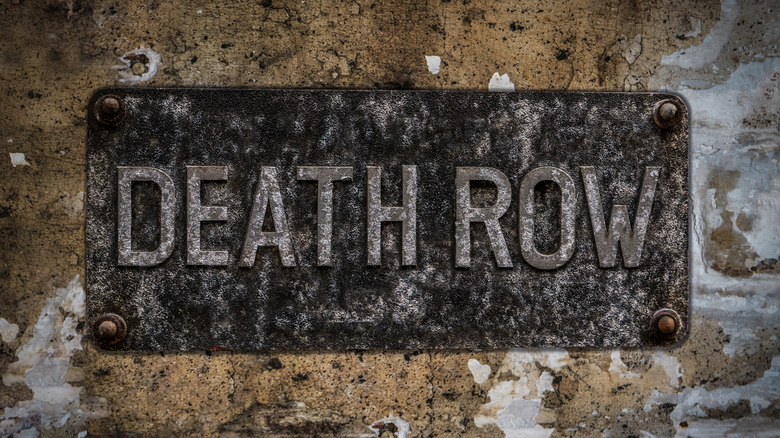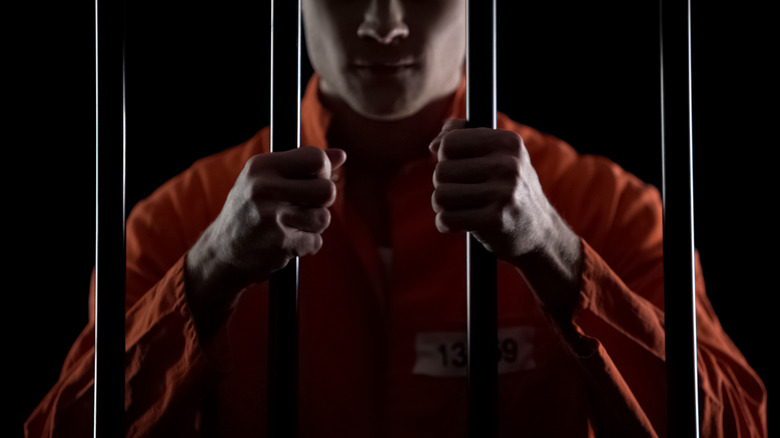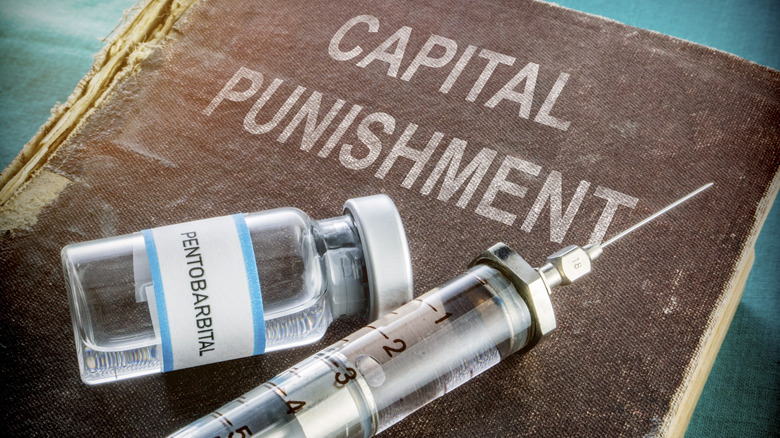What Happens If A Death Row Execution Fails The First Time?
The death penalty has been around in the United States for hundreds of years, and the first recorded execution occurred in 1608 in Virginia's Jamestown colony. The man who was executed was named Captain George Kendall, who was accused of being a spy for the Spaniards. Being a spy was a grave offense but back then, even minor crimes — such as stealing, trading with American Indians, or killing chickens — were punishable by the death penalty (via Death Penalty Info).
Various means have been used to carry out executions throughout the years including hanging, a firing squad, electrocution, and the gas chamber. Today, however, the primary method of execution is lethal injection in most of the states that authorize capital punishment, but there are secondary methods authorized as well. Carrying out the death penalty isn't as easy, though, and as Statista reported, lethal injection accounted for the highest percentage of botched executions from 1890 to 2010.
The process of lethal injection
Lethal injection is the primary method of execution, as it is regarded as the most "humane" way to carry out the death penalty and it was said to be quick and painless. However, reports say that's not always the case, and when it is botched, the inmate may experience what some would describe as torture (per NPR). Dr. Joel Zivot, who studied the autopsy reports of several inmates, said, "I began to see a picture that was more consistent with a lower death. A death of organ failure, of a dramatic nature that I recognized would be associated with suffering."
According to How Stuff Works, execution via lethal injection is carried out using three types of drugs. The first one is an anesthetic that puts the inmate to sleep, the second is a paralyzing agent that halts the breathing, and the third is the toxic agent that induces cardiac arrest. If the right doses are given and everything goes according to plan, the inmate should be dead within minutes after administering the final injection. In most cases, however, the process isn't carried out by a medical professional, and there have been accounts of inmates surviving the first attempt of execution.
What happens when the inmate survives?
There have been several reported incidents of executioners failing at taking a person's life on the first attempt. As ATI reported, 276 out of 8,776 executions carried out from 1890 to 2010 were botched. Some of the problems encountered include the malfunctioning of electric chairs, wrong administration of drugs, human error, or simply because the inmate survived the procedure.
When this happens, executioners do not stop the process until the inmate is dead, according to Mental Floss. In some instances, this can take a few attempts, which leads to the inmate suffering immensely before death. Throughout the years, Death Penalty Info has recorded a number of failed first attempts of execution on the electric chair and via lethal injection. In the event that the execution couldn't be carried out on the scheduled date due to unforeseen circumstances, it will be postponed to a later date.
Violation of death row inmates' rights
Those who are facing the death penalty have rights that specifically cater to their protection, and one of them has to do with the execution. According to the Office of the High Commissioner of the United Nations Human Rights, "where capital punishment occurs, it shall be carried out so as to inflict the minimum possible suffering." When botched executions occur, though, the right to have "minimum possible suffering," more often than not, is violated.
In 1965, William Vandiver was strapped to the electric chair but the first jolt of electricity failed to kill him. In total, five jolts of 2,300 volts were administered to successfully complete the execution, and the process took 17 minutes. In 2007, Christopher Newton was executed via lethal injection, but the entire process took two hours to complete. Officials struggled to find a suitable vein to administer the drugs, and Newton was prodded at least 10 times with a needle before he was declared dead. In 2014, Dennis McGuire reportedly clenched his fists and gasped for air for 25 minutes before the drugs administered took effect, and it was evident to witnesses that he suffered immensely before he stopped breathing (via Death Penalty Info).
Percentage of botched executions
While researching for his book "Gruesome Spectacles: Botched Executions and America's Death Penalty," Professor Austin Sarat discovered that from 1890 to 2010, 3% of the executions carried out didn't go as planned. "If you look over the course of the 20th Century, about 3% of all American executions were botched," he said, per the BBC. And of the number of botched executions, 7.1% were done via lethal injection. By definition, botched executions are "those involving unanticipated problems or delays that caused, at least arguably, unnecessary agony for the prisoner or that reflect gross incompetence of the executioner" (via Death Penalty Info).
The subject of botched executions has caused controversy, and many question whether it is legal to continue the execution if the inmate survives the first attempt, as they deem the succeeding attempts a form of torture, as reported by Mother Jones. However, the U.S. Supreme Court declared that a botched execution caused by equipment failure does not constitute the violation of a death row inmate's rights, as it doesn't cause unnecessary pain.
Doyle Lee Hamm case
Doyle Lee Hamm was a murderer who was scheduled to be put to death on February 22, 2018. Years before his execution, Hamm was diagnosed with cranial cancer and lymphoma, which caused issues on his veins during execution. The execution team poked and prodded Hamm for almost three hours, and they finally stopped the attempts when the legal death warrant expired, as reported by the New York Times. During the attempts, Hamm repeatedly hoped the team "could get it over with" to end the pain he experienced. His lawyer, Bernard Harcourt, said, "This was a bit of butchery that can only be described as torture."
Harcourt filed a civil rights lawsuit against the Alabama Department of Corrections, stating that attempting the execution again would be a violation of the law against cruel and unusual punishment and calling what happened during failed attempt a "wrongful execution." Negotiations took place, and they came to a confidential settlement, per the Montgomery Advertiser. Hamm's sentence was commuted to life imprisonment. He died in prison of natural causes in 2021.





